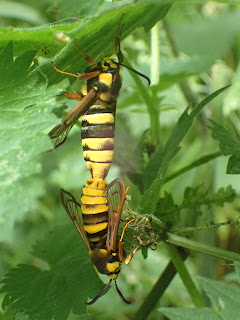Early July 2022
Some close scrutiny of various trees resulted in some new species on my daily walks to and from work. Firstly Alder, where I managed to find the psyllid Baopelma foersteri, a slightly yellowier version of the common Psylla alni. On Ash I had recorded Psyllopsis fraxini as an agg from both the galls and an adult, but I took the time to check an adult male and confirmed it was definitely that species. I also found a green psyllid on Ash, which as expected turned out to be Psyllopsis fraxinicola. The British Spiders Twitter account had mentioned that it was a good time of year to look for the tiny spiders and eggsacs of Paidiscura pallens and Theridion varians. I already find lots of the former, but with a bit of hunting I managed to find the latter as well at Wensum Park. A brood of Egyptian Geese and a Grey Wagtail were also seen in Wensum Park.
Elsewhere in the city new aphids included Knotgrass Aphid Aphis polygonata, Mullein Aphid Aphis verbasci and Lupin Aphid Macrosiphum albifrons.

















































.JPG)
